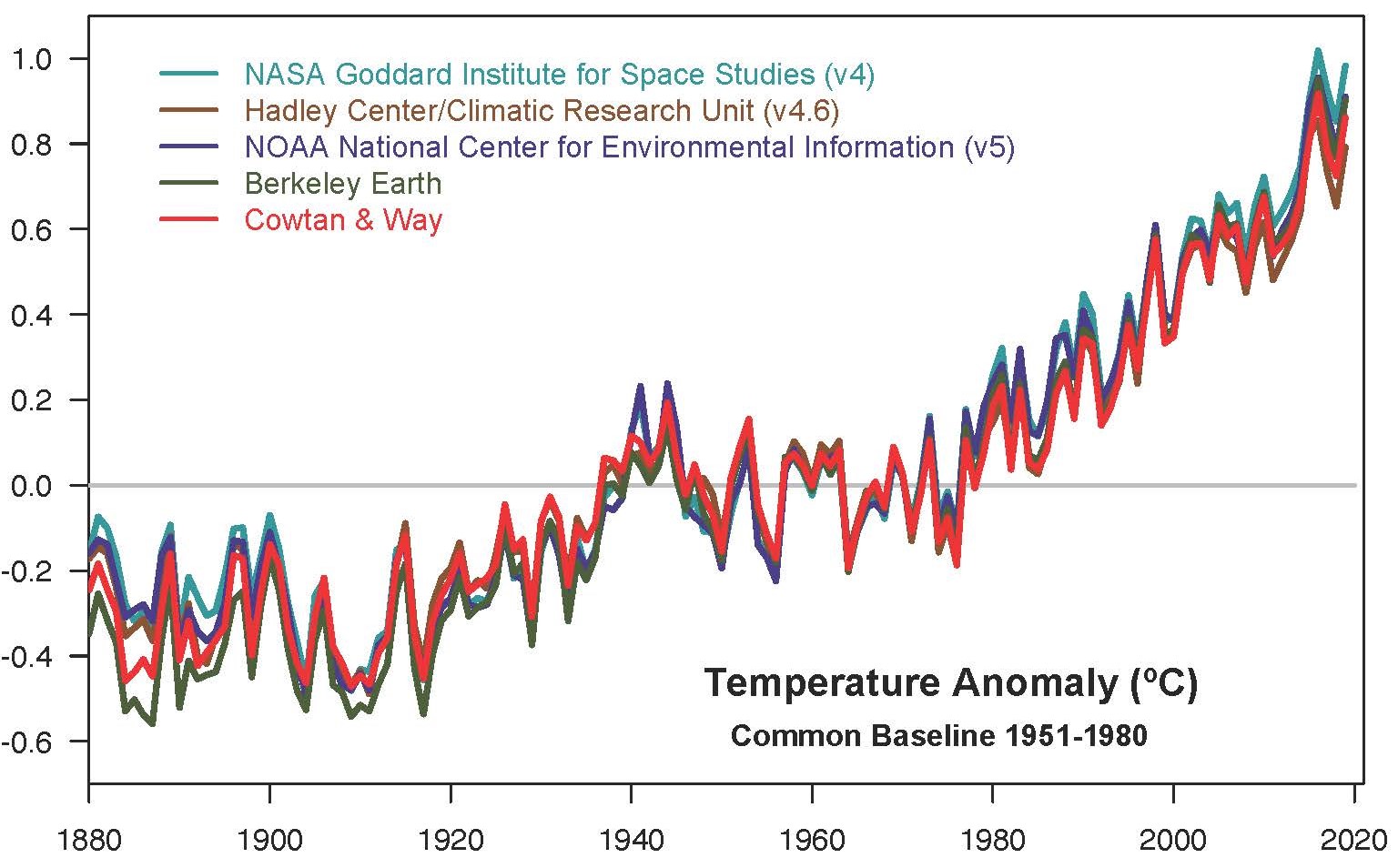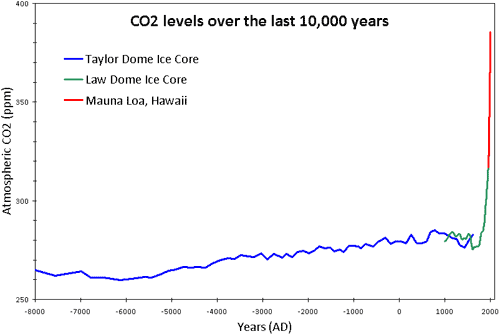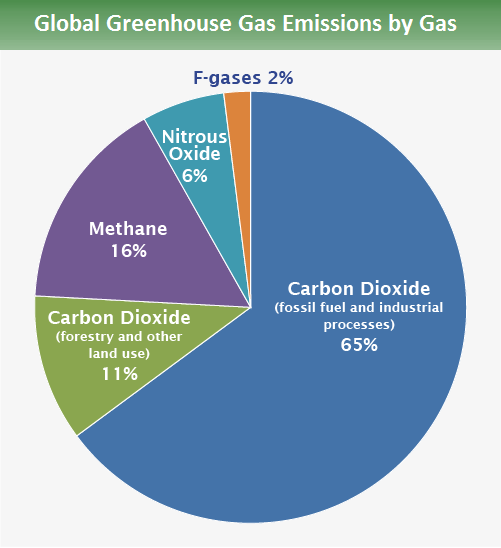Climate Change
 Climate change is an abnormal long-term change in weather affecting a region or the entire earth. Periodic climate change is normal and pervasive throughout history.
Climate change is an abnormal long-term change in weather affecting a region or the entire earth. Periodic climate change is normal and pervasive throughout history.The Sahara Desert, the Amazon Basin, and Antarctica rouse images of distinct climates along the spectrum of what we call climate. Were Antarctica to transform into a hybrid of the Amazon and the Sahara, we would all agree a dramatic climate change would have occurred. Indeed, 120 million years ago, Antarctica was such a hybrid as depicted in an artist's rendering of its typical landscape constructed from examining fossils collected by the British Antarctic Survey. And 120 million years is less than 3% of the earth’s age. Imagine the climate change that has occurred throughout geological history. But the global warming debate is not about climate changes spanning hundreds of thousands of years, it is about approximately 150 years over which humans are suspected to have influenced the earth's climate.
| Antarctica reconstructed using fossils 120 million years old |
The present concern is whether the human population and technology are producing greenhouse gases in amounts that harm the environment, perhaps irreversibly. The Earth's average temperature has changed little during the Holocene Epoch, the 12,000 of relatively stable climate since the last ice age. The global warming controversy is about a much smaller slice of time named the Anthropocene, a name popularized in 1990 by atmospheric chemist and Nobel laureate Paul Crutzen representing the period of time during which human activity might have had a dominant impact on climate.
The cause of global warming has become a divisive issue between climate activists who argue global warming caused by humans will cause an irreversible degradation of our environment, and climate deniers who argue periods of global warming are natural fluctuations in climate having little to do with modern industrial activity. Global warming activists and deniers each have their own political, financial and ethical motivations for their positions, and both sides naturally engage in some degree of confirmation bias that intensifies the debate and echos the "proof" supporting their respective positions (for example, here is a thorough summary of the arguments made by deniers).
After searching for, fact-checking, and carefully evaluating the arguments on both sides of the controversy the subject I am convinced of two critical conclusions: Humans are causing statistically significant increases in global warming, and we are not yet at the irreversible tipping point that condemns the environment to desolation. There are reasonable steps that both activists and deniers can take to help ensure a future environment that can continue to sustain life and preserve a viable environment (albeit one different than we presently experience).
If you are comfortable on an extreme end of the spectrum of opinions on the topic, consider looking elsewhere for information that appeals to you, or rethink how you might reconcile your opinions with the facts I summarize here.
Global Warming
 |
| Global Temperature Chart 1850 - 2019 |
Greenhouse Gases
Four natural greenhouse gases matter most: carbon dioxide, nitrous oxide, methane, and ozone. These have been present in quantities that balance the earth's life-supporting energy budget. Scientists have studied each of the greenhouse gases to assess how human activity is affecting the mix. The global warming controversy is about the credibility of those studies and their conclusions.
To evaluate the impact of each gas requires one to weigh the power of its greenhouse effect together with its life in the atmosphere. A molecule from a cow fart stays in the atmosphere for only a decade or so but has 80 times more potential to warm the atmosphere than a molecule of carbon dioxide which stays in the atmosphere for thousands of years. Which is the greater threat to the environment? Read on.
When studying climate change data two issues, among others, must be carefully addressed. First, the researcher must take care to distinguish correlation from causation (e.g., nine months after the longest darkest nights in Europe when storks migrate, a large number of babies are born in Europe, but we adults know storks don't bring babies). Second, time-series data (data collected over time) must be adjusted to be as consistent as possible to take into account changes in measurement devices, the origin of samples, the collection process, methods of sample analysis, and human error recording or reporting data.
Correlation Versus Causation. Nobel Prize recipient, Clive Granger, developed the Granger-causality test based on the idea that a necessary but not sufficient condition for cause and effect is that the cause must precede the effect (to oversimplify the point, if the babies arrive before the storks fly, look for another cause). Statistical advancements since Granger causality (developed in 1969) are frequently used to eliminate spurious correlations in climate data. Professional statisticians are quite capable of adequately sorting causal relationships from spurious ones but rarely with 100% certainty. It takes more than a few carefully constructed studies to reach a conclusion that can be treated as a scientific fact.
For example, the now-established fact that smoking causes lung cancer was hotly disputed in the 1950s. A number of studies, mostly sponsored or promoted by tobacco companies, claimed to prove that the link was based on correlations and not causation. The word agnotology was coined in 1995 and the smoking-cancer link became a classic example. Subsequent scientific research is virtually undisputed: smoking does cause lung cancer.
Adjusting Time Series Data. More than 60 years ago Charles Keeling installed an instrument he designed on top of Mauna Loa, HI. His instrument was the world's first daily data recording of atmospheric carbon dioxide. The continuous daily record, called the Keeling curve, has been maintained for more than 60 years and continues today. The Keeling Curve is an exceptionally reliable method of collecting data on atmospheric carbon dioxide; all samples are taken in the place and consistently analyzed on-site.
By employing scientific and statistical tools to ensure that climate data are consistently and accurately reported there is an exceptional degree of agreement between different sources of global warming charts.

The CO2 levels measured over thousands of years also nicely aligns with recent data. In the chart below, the Keeling Curve is appended to 10,000 years of atmospheric carbon dioxide data extracted from air bubbles trapped in two of the most reliable Antarctica ice cores. The air samples from Antarctica ice cores have been adjusted for both thermal diffusion and gravitational settling (among other complexities) to provide reasonably accurate readings of carbon dioxide (and other gases) over a 650,000 year period.

Atmospheric Warming
Five greenhouse gases matter most: water vapor, carbon dioxide, nitrous oxide, methane, and fluorinated gases. The first four of these have been present in the optimum mix to balance the earth's life-supporting energy budget, fluorinated gases are manmade. The primary human activity producing greenhouse gases is emission from burning fossil fuels for electricity, heat, and transportation.
Carbon Dioxide
More than 160 years ago Eunice Foote filled three glass jars with different gases -- water vapor, air, and carbon dioxide -- to determine how they retained heat when exposed yo the sun. At a US conference held in 1856, she reported how long each remained warm. She announced that carbon dioxide required significantly more time to cool than the other jars. She then speculated that if in history the earth's air had a greater portion of carbon dioxide the temperature on earth would have been warmer.
Today the vast majority of scientists who study global warming are acutely aware of, and carefully control for, the many known causes of global temperature variations such as volcanic activity, El Niño, fluctuations in solar radiation, minute particles in the air originating on earth, and differences in temperature measurement technologies and record-keeping over time. CO2 and its companion, water vapor, work together to maintain life on earth. Water is the dominant greenhouse gas in our atmosphere both by weight and volume; no other greenhouse gas is capable of trapping more heat in our atmosphere. But the concern with global warming is not about the amount of heat a gas can trap but is how long the gas remains in the atmosphere and therefore contributes to accumulative increased air temperatures. CO2 is far less reversible than other emissions; it remains in the atmosphere for thousands of years and therefore is of the greatest concern.
CO2 and its companion, water vapor, work together to maintain life on earth. Water is the dominant greenhouse gas in our atmosphere both by weight and volume; no other greenhouse gas is capable of trapping more heat in our atmosphere. But the concern with global warming is not about the amount of heat a gas can trap but is how long the gas remains in the atmosphere and therefore contributes to accumulative increased air temperatures. CO2 is far less reversible than other emissions; it remains in the atmosphere for thousands of years and therefore is of the greatest concern.Water vapor
Water vapor is a greenhouse gas because it captures and holds heat but is not directly manmade and precipitates out in a matter of hours or days. However, warmer temperatures cause more water vapor in the atmosphere and therefore can enhance the warming effect of other greenhouse gases. Human activity affects the amount of water vapor in the air by influencing the presence of other greenhouse gases. CO2 emissions are primarily associated with the burning of fossil fuels.
Methane
Methane emissions are less than one-fifth that of CO2 and stay in the atmosphere a little more than a decade but have 25 times the warming potential while in the air. Thus methane pollution is more reversible than CO2. Some methane originates from human waste and agricultural production, but most methane emission is caused by producing oil, coal, and natural gas.
Nitrous oxide
Nitrous oxide occupies an even smaller slice of the emissions pie chart, stays in the atmosphere about a century, but has 300 times the warming potential as CO2. Nitrous oxide emissions come from agricultural production (about 75%), fuel combustion (20 % - mostly vehicles), and waste management.
Global Warming And Human Activity
The more critical question is, are we near or at the ultimate tipping point where human activity cannot stop climate change that, as the cartoon states, "...humans have just about run their course and [earth] should be on the mend soon?"
A tipping point in climate change is a climate condition that is cannot be stopped by human intervention. There is a series of tipping points that could culminate in an existential catastrophe some of which may be permanent. We do have a number of techniques and technologies capable of carbon dioxide recovery (CDR) but they alone are not sufficient to overcome the climate warming trend.
I taught at UCSD for a dozen years with research scientists and statisticians including Charles Keeling and Clive Granger and learned that no matter how much research I personally undertake, my opinions must take account of the better-informed experts I have come to respect.
Kate Gordon, a fellow at the Columbia Center on Global Energy Policy, writes regarding CDR “We also need a pretty significant federal R&D budget dedicated to these [CDR] strategies so we can start improving the technology and get a better grasp on how much it does cost to do each of these things, how effective they are and how safe they are.”
Ralph Keeling, a professor of geochemistry at Scripps Institute of Oceanography and son of Charles Keeling, recently said: "...the only way to halt the trajectory of the Keeling Curve is to significantly cut fossil fuel emissions."
While CO2 readings are currently at their highest level since humans have inhabited earth, Martin Siegert, co-director of the Grantham Institute at Imperial College London, recently stated: "For millions of years, we haven't had an atmosphere with a chemical composition as it is right now.”
But then closed with a succinct summary of my conclusion on this subject. Siegert said he is buoyed by the actions of young environmentalists who understand what's at stake in the climate crisis and are demanding change. "They get it in a way that decision-makers right now don't, so I'm optimistic, because I think, in the next 30 years, we'll be in good hands.”
yurtdışı kargo
ReplyDeleteresimli magnet
instagram takipçi satın al
yurtdışı kargo
sms onay
dijital kartvizit
dijital kartvizit
https://nobetci-eczane.org/
İ167